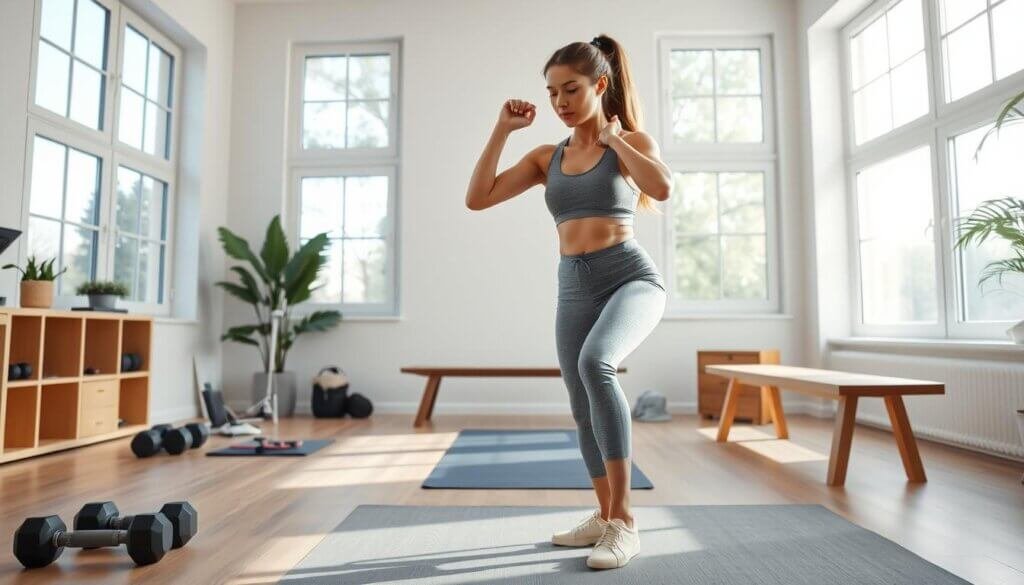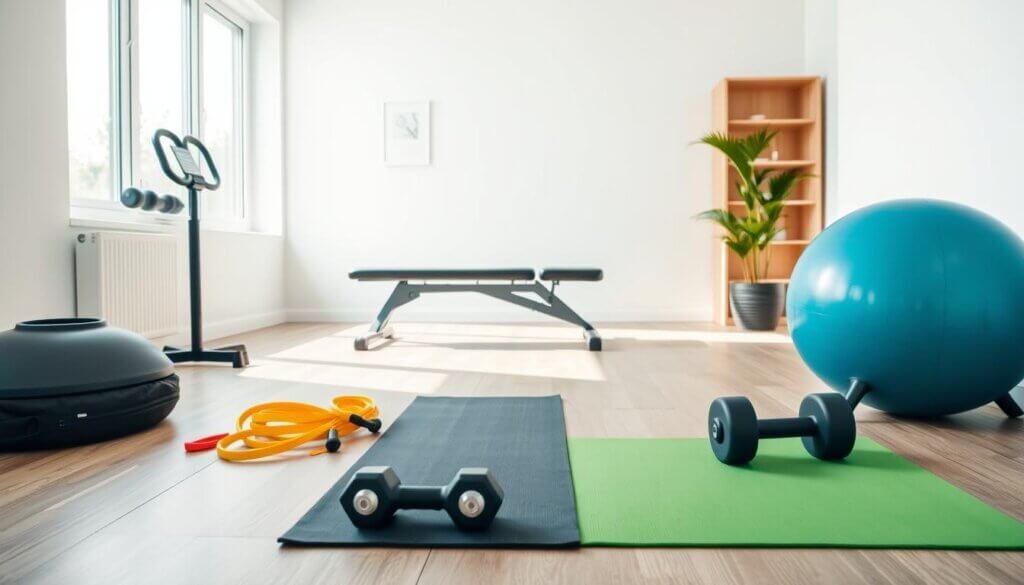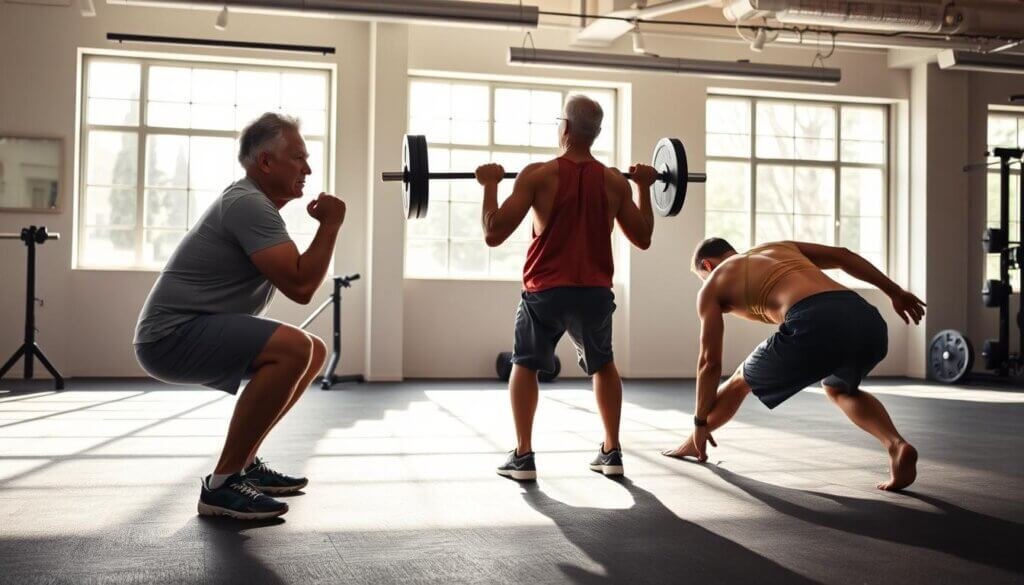Table of Contents
I’m starting my fitness journey and I know it’s key to learn full body workouts for beginners. These exercises are a great start. They help me build strength and endurance for the long run. A beginner’s full body workout plan lets me slowly get used to different exercises.
I love circuit training because it’s flexible and easy to start. It mixes strength, cardio, and endurance exercises. This makes it both good and quick. As I learn the basics, I feel more confident. This helps me stick to a routine that fits my goals.
Key Takeaways
- Full body workouts cater to beginners, emphasizing a gradual introduction to exercise.
- Understanding movement patterns is crucial for building strength and avoiding injury.
- Circuit training combines various exercise types, promoting efficiency and fat loss.
- Confidence and familiarity with exercises are essential for long-term fitness success.
- A well-structured workout plan fosters consistency and accountability.
Understanding Full Body Workouts
A beginner full body workout works all big muscles at once. It’s great for newbies because it saves time and builds strength fast. You don’t need to spend hours in the gym.
Doing a full body workout at home is efficient. It helps you get strong, stay flexible, and boost endurance. It’s a smart way to start your fitness journey.
Full body workouts teach you to work on many muscles at once. This is key for getting strong without getting hurt. Training each muscle 2 to 4 times a week helps you grow muscles faster.
These workouts usually have 1–2 exercises for each muscle group. They last about 45 minutes. A typical week might be: Monday (workout), Tuesday (rest), and so on.
Full body workouts are also good for home use. You can use adjustable weights or bodyweight exercises. They help you burn calories and get stronger.

The Benefits of Full Body Workouts for Beginners
Starting a fitness journey can feel scary, but full body workouts help. They are good for beginners because they make you strong and healthy. Plus, they save time and are simple to do.
Improved Muscle Balance
Full body workouts help beginners get muscles balanced. They work all big muscles at once. This stops strength imbalances and injuries.
Doing squats and deadlifts makes you stronger. It also means you won’t get too sore. So, you can work out more often without needing to rest too long.
Efficiency in Fat Loss
Full body workouts also help you lose fat fast. They make your heart rate go up and burn more calories. This is great for keeping your weight in check.
They also make your heart and muscles stronger. Since they’re quick, busy people can stay fit without spending hours at the gym. Doing three full body workouts a week helps beginners stay on track and see better results.
Essential Movement Patterns in Beginner Workouts
For beginners, knowing essential movement patterns is key. These patterns are the base of good training. They help build a strong foundation in strength.
By focusing on these patterns, workouts become more effective. This way, I get stronger and avoid injuries.
Horizontal and Vertical Push Movements
Horizontal push movements include push-ups and bench presses. They work the chest, shoulders, and triceps. This builds upper body strength.
Vertical push movements, like the dumbbell overhead press, add to this strength. They also improve stability and joint health. Adding both to workouts makes the upper body stronger and more balanced.
Core Flexion and Stability
Core flexion and stability exercises are crucial. A strong core is key for body stability and function. Exercises like hanging knee raises and planks boost core strength.
This helps in doing better in push and pull movements. Building core strength makes workouts better and prepares for harder training later.
Full Body Workouts for Beginners: Start Strong
A good full body workout plan for beginners is key to getting stronger and fitter. There are three levels for beginners, each for different skills. Level One uses simple bodyweight exercises for newbies. Level Two adds weights to improve muscle control. Level Three uses harder exercises that work many muscles at once.
The main movement patterns to focus on are:
- Horizontal Push
- Vertical Push
- Horizontal Pull
- Vertical Pull
- Hinge Movement Pattern
- Squat Movement Pattern
- Static Lunge Movement Pattern
- Dynamic Lunge Movement Pattern
- Core Flexion Movement Pattern
- Carry Movement Pattern
Using resistance bands can make pull-ups easier by 50 to 80 pounds. Exercises like Cable Pull Through and Romanian Deadlift help strengthen the back. The Rollup helps control the core.
For beginners, it’s better to focus on doing things right than doing a lot. Start with gym workouts three to four times a week. Make sure to rest fully one day a week. Each workout should mix strength training, mobility, and cardio. Here’s a sample three-day plan:
| Day | Workout | Cardio | Mobility |
|---|---|---|---|
| Day 1 | 40 minutes of full body strength | 10 minutes | 10 minutes |
| Day 2 | 25 minutes full body workout | 25 minutes | 10 minutes |
| Day 3 | 40 minutes of full body workout | 10 minutes | 10 minutes |
By sticking to this plan and focusing on key movements, I’ll build a strong foundation. This will help me get better without getting hurt.
Creating a Beginner Full Body Workout Plan
When starting a workout plan, it’s key to cover all muscle groups. Doing full body workouts 2-3 times a week is great. This lets muscles recover for 48 hours, avoiding injury and helping them grow.
Recommended Weekly Frequency
Experts say beginners should follow a set weekly plan. Here’s a simple one:
| Day | Workout Type |
|---|---|
| Monday | Full Body Workout |
| Tuesday | Rest or Light Activity |
| Wednesday | Full Body Workout |
| Thursday | Rest |
| Friday | Full Body Workout |
| Saturday | Active Recovery |
| Sunday | Rest |
Warm-Up and Cool Down Importance
Knowing the value of warm-ups and cool downs is vital. A good warm-up gets muscles ready, boosts blood flow, and makes you flexible. A cool down helps your body recover, easing muscle stiffness.
I suggest warming up for 5 minutes with dynamic stretches or light cardio. For cooling down, use static stretches on big muscle groups.
Beginner-Friendly Full Body Routines
Starting a workout routine can be easy and fun. Beginners can mix dumbbell exercises with bodyweight movements. This mix helps everyone, no matter their fitness level.
These routines need little equipment and use simple exercises. They focus on being flexible and growing stronger over time.
Workout with Dumbbells
Dumbbell exercises are great for beginners. Here’s a simple workout plan using dumbbells.
| Exercise | Repetitions | Sets |
|---|---|---|
| Goblet Squats | 8-12 | 3 |
| Dumbbell Bench Press | 8-12 | 3 |
| Dumbbell Rows | 8-12 | 3 |
| Dumbbell Lunges | 8-12 per leg | 3 |
Incorporating Bodyweight Exercises
Bodyweight exercises add variety and ease. They work well with dumbbell exercises for beginners. Here are some bodyweight exercises to add to your routine:
| Exercise | Repetitions | Sets |
|---|---|---|
| Push-Ups | 6-12 | 3 |
| Glute Bridges | 12-15 | 3 |
| High Plank | 30-60 seconds | 2-3 |
| Superman Pull-Downs | 12-15 | 3 |
These routines help build strength and confidence. They mix dumbbell and bodyweight exercises. This mix helps you grow stronger as you train more.
What Equipment Do I Need For a Beginner’s Full Body Workout?
Starting a fitness journey needs the right tools. The right equipment makes workouts better. I use key items for full body workouts at home or the gym.
Essential Equipment: Dumbbells and Resistance Bands
Dumbbells and resistance bands are key for beginners. Dumbbells help with many exercises. I start with weights from five to twenty-five pounds.
Resistance bands add more challenge. They help work muscles without heavy weights. These two are the heart of my workout routine.
Optional Equipment for Enhancement
While dumbbells and bands are enough, some extras make workouts better. An exercise mat makes floor exercises comfy. A bench is great for chest presses and dips.
A stability ball adds fun with balance and core exercises. These extras keep my workouts interesting. They help me stay on track without spending a lot.

Designing a Simple Full Body Exercise Routine for Beginners
Creating a simple full body exercise routine for beginners is easy. Choose exercises that build basic strength and work on big muscle groups. Start with two to three full-body workouts each week. This keeps your body balanced without getting too tired.
Begin with compound exercises like squats, deadlifts, and bench presses. These exercises work many muscles at once, helping you get stronger. Do two sets of 8-12 reps to start. When you get stronger, add more sets.
Start with the hardest exercises first. This helps avoid injuries and focuses on good form. Mix exercises that work opposite muscles to help your body recover better. For example, do chest and back exercises together.
Begin with a 60-second warm-up of three light drills. Stretch after your workout to help your body recover. Rest for 2-5 minutes after doing compound lifts and 1-2 minutes for isolation exercises.
Gradually get better with each workout. This simple routine is great for busy people. It works all major muscles, preparing you for more strength and health in the future.
How to Perform Basic Full Body Workouts for Beginners
Starting a full body workout can feel hard for beginners. It’s important to learn the right techniques to avoid injuries. Making changes to fit your fitness level is key. I’ll talk about the importance of good form and share easy workout tips for all.
Proper Techniques and Form
Good form is crucial in workouts. It helps prevent injuries and makes exercises more effective. Here are some tips:
- For knee push-ups, keep your elbows at 90-degree angles. This helps your shoulders stay stable.
- In lateral raises, start with light weights. This protects your shoulders and builds strength slowly.
- In bird dog exercises, keep your arm and leg straight. Your hips should be over the mat.
- When doing triceps extensions, make sure your grip can handle the weight.
Modifications for Different Fitness Levels
Every beginner is different. Using workout modifications helps everyone feel confident. Here are some suggestions:
- If lunges hurt, try low-impact exercises that work similar muscles.
- Start with bodyweight exercises in Level One routines. They build a strong base.
- Move to Level Two with weights when you get stronger. This boosts muscle efficiency.
- Always talk to a doctor before starting any workout plan, even if you’re healthy.
Beginners should work out for 45 minutes, 1 to 3 times a week. Take a full day off between workouts. Begin with a 5 to 10-minute warm-up and end with a cool-down. Staying focused on proper techniques and making adjustments will help you on your fitness path.
Common Mistakes to Avoid in Full Body Workouts
Beginners often face many challenges when starting full body workouts. Many start strong but then make common mistakes. These mistakes can slow progress and cause injuries.
It’s important to focus on correct form and get enough rest. Knowing these mistakes helps us train better and avoid injuries.
Incorrect Form Leading to Injury
Using the wrong technique is a big mistake. Beginners might not know it, but wrong form increases injury risk. Studies show working with a personal trainer can lower injury rates.
They teach the right way to do exercises. Keeping the body aligned and balanced is key. Warming up before workouts also helps avoid injuries, which is important for intense routines.
Overtraining as a Beginner
Many new exercisers push too hard too soon. This can cause fatigue and slow progress. It’s important to let the body recover.
Experts say to take at least one rest day a week. This prevents burnout. Paying attention to when you’re tired helps make workouts more enjoyable and leads to better results.

Tracking Your Progress in Full Body Workouts
It’s key to track your fitness progress. This keeps you motivated and makes sure your workouts are working. By seeing your results, you can find what needs work and change your routine. Setting goals helps you stay on track with your fitness goals.
Setting Realistic Goals
Setting realistic goals changes how you work out. Instead of vague dreams, aim for specific, measurable, achievable, relevant, and time-bound (SMART) goals. For example:
- Do 3 full-body workouts each week.
- Up your strength training weights by 5-10% every 3-4 weeks.
- Try to do 150 minutes of moderate aerobic activities weekly.
These goals help you focus on what’s important. You’ll feel a sense of achievement as you get better.
How to Log Your Workouts Effectively
There are many ways to log your workouts. You can use fitness apps or keep a simple journal. Here are four ways I recommend:
- Use fitness apps to record what you do, how long, and how much.
- Keep an exercise journal to write down your workouts and how you feel.
- Take photos or videos of your form to see how you’re improving.
- Check your fitness levels every two months to see how far you’ve come.
Each method helps you track your progress and stay on track with your goals. Regularly checking your goals and progress can help you get even better at fitness.
Finding Motivation for Your Beginner Workouts
Staying motivated is key, even at the start. Having a strong support system is vital. It keeps me going and celebrates my small wins.
Being around people who share my goals makes me feel accountable. It inspires me to reach my fitness dreams.
Creating a Support System
Friends, family, or workout buddies can be part of your support team. Sharing goals with others creates a sense of community. This boosts motivation for beginners.
Sharing our fitness journeys, successes, and struggles empowers us. Group activities, online or in-person, make workouts more fun. They help us stay on track with our fitness plans.
The Role of Accountability in Fitness
Accountability is a big motivator for me. Regular check-ins with workout partners or fitness classes keep me on track. It’s like having someone watch over me.
Even posting my workout plans online helps. It adds a sense of responsibility. This drives me to succeed.
| Support System Element | Impact on Motivation |
|---|---|
| Workout Buddy | Increases effort and accountability |
| Fitness Group | Encourages shared goals and experiences |
| Online Community | Provides motivation through shared progress |
| Regular Check-ins | Maintains commitment to fitness routines |
Conclusion
Beginner workouts that cover the whole body are great for getting stronger and more fit. They help me build muscle and endurance. It’s important to rest enough and work all major muscles.
Studies show that doing these workouts 2-3 times a week is best. It helps muscles grow evenly and boosts my metabolism. This makes my training efficient and easy to follow.
Full-body workouts also make me move better. This is key for lasting progress. Keeping a healthy diet is as important as exercising.
I plan to keep trying new things to stay excited about working out. Staying true to these tips will help me reach my fitness goals. This will lead to a healthier life for me.
FAQ
What is a full body workout for beginners?
A full body workout for beginners works all major muscles at once. It’s a great way to get stronger and fitter.
How often should I do full body workouts as a beginner?
Beginners should do full body workouts 2-3 times a week. Make sure to rest for at least 48 hours in between.
What are some beginner-friendly full body exercises I can do at home?
Good exercises for beginners at home include squats, push-ups, lunges, planks, and dumbbell overhead presses.
Do I need any equipment for full body workouts for beginners?
A pair of dumbbells is enough. But, you can also use resistance bands and other optional gear like an exercise mat or stability ball.
What fundamental movement patterns should beginners focus on?
Beginners should work on horizontal push movements (like push-ups), vertical push movements (like dumbbell overhead presses), and core stability exercises. This builds a strong base.
How can I ensure I’m using proper techniques and form during my workouts?
Start with lighter weights and focus on your body’s position. Watching instructional videos or getting help from a trainer can also help.
What are common mistakes to avoid during full body workouts?
Avoid using wrong form, lifting too heavy, and not resting enough. These can cause injuries.
How can I track my progress with my full body workouts?
Track your progress by setting goals, using fitness apps, or keeping a workout journal. This helps see how far you’ve come.
What can I do to stay motivated during my fitness journey?
Stay motivated by finding workout buddies or joining fitness groups. Also, make sure to follow your workout plans.
